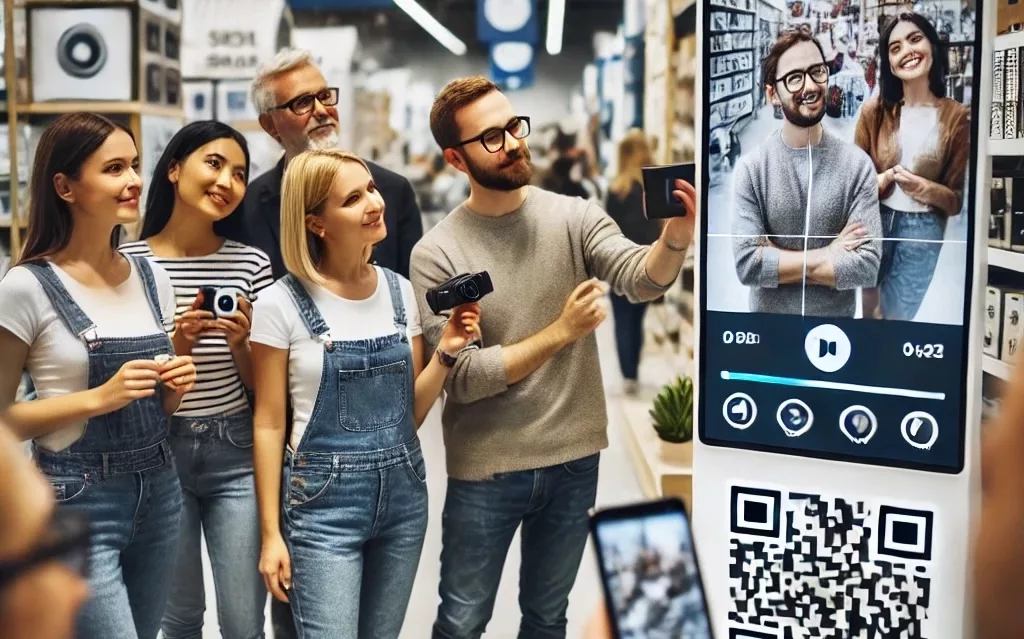Why Video Co-Creation is the Future of Marketing
In today’s digital world, content isn’t just consumed—it’s co-created. Consumers are no longer passive recipients of marketing messages; they are active participants in shaping brand narratives. Brands that invite consumers into the creative process aren’t just getting engagement; they’re fostering a community and creating long-term loyalty.
Video co-creation is reshaping how brands interact with their audience, leading to crowdsourced video content that’s authentic, engaging, and impactful. This type of content allows real consumers to tell a brand’s story in their own words, showcasing real-life experiences, emotions, and connections.
With the rise of interactive video marketing, consumers aren’t just watching—they’re participating. LTK (formerly RewardStyle) has revolutionized online shopping by empowering influencers to share genuine product recommendations, driving engagement and brand loyalty.
What is Video Co-Creation?
Video co-creation is when brands collaborate with their customers, fans, or employees to create engaging content. Instead of relying solely on in-house production teams or agencies, brands leverage their audience’s creativity to produce crowdsourced video content that aligns with their marketing message.
Examples of Successful Video Co-Creation
- Nike’s “You’re It” Campaign: Nike invited everyday athletes to submit videos showcasing their best moments in sports, turning real users into stars of their marketing campaigns.
- Chipotle’s TikTok Challenge: Chipotle encouraged customers to create short videos performing a “lid flip” challenge, resulting in millions of views and organic shares.
- Flip’s Social Shopping Evolution: Flip expanded its platform beyond traditional shopping, encouraging community-driven video content and blending entertainment with commerce.
Why Brands Are Embracing Video Co-Creation
The rise of video co-creation isn’t just a marketing fad—it’s a strategic shift in how brands connect with their audiences. Traditional advertising no longer holds the same power it once did. Consumers demand authenticity, engagement, and a sense of belonging. Brands that tap into crowdsourced video content don’t just create compelling ads; they build communities around their products.
1. Authenticity Drives Trust
Consumers today are more skeptical of traditional advertising than ever before. They can spot a scripted ad from a mile away, and they’re quick to dismiss overly polished marketing messages that feel forced. According to a Stackla study, 90% of consumers say authenticity is important when deciding which brands to support. This means people are far more likely to engage with content that feels genuine, raw, and human.
User-generated video content, by its very nature, feels real—because it is. Whether it’s an unboxing video, a product testimonial, or a fan-led challenge, UGC marketing taps into real-life experiences that resonate far more than a traditional brand message.
Example: Nike has successfully used video co-creation as a key part of its marketing strategy. Their “You Can’t Stop Us” campaign featured a mix of athlete-generated content, user submissions, and professional footage, making it one of the most engaging campaigns in recent years. The result? Over 50 million views in its first month alone.
2. Higher Engagement Rates
Interactive content isn’t just more fun—it’s also more effective. According to a Deloitte study, interactive content sees twice the engagement of traditional formats. People are more likely to watch, comment, share, and contribute when they feel involved in the creation process.
Example: McDonald’s #MyMcDonaldsFanContest invited fans to submit short-form videos showcasing their love for the brand. The campaign resulted in millions of user-submitted videos, which McDonald’s repurposed across their social platforms. This led to a 25% increase in social media engagement and a boost in brand sentiment.
3. Cost-Effective Content Production
Video production isn’t cheap. Hiring professional videographers, actors, and production teams can easily cost tens of thousands of dollars per campaign. But what if your audience could create high-quality content for you?
This is where crowdsourced video content shines. Instead of spending massive budgets on production, brands can leverage mobile video creation platforms to guide users in creating content that aligns with their marketing goals.
Example: GoPro’s entire marketing strategy is built on user-generated content. Instead of producing commercials, they encourage customers to submit videos shot on their GoPro cameras. This approach has led to millions of submissions, with GoPro repurposing the best footage for their campaigns—without spending a fortune on production. (GoPro)
4. Strengthened Community Connection
The strongest brands aren’t just selling products—they’re building communities. Video co-creation isn’t just a marketing tool; it’s a community engagement strategy that fosters deep, long-lasting connections between brands and their audiences.
Example: LEGO’s “Rebuild the World” campaign encouraged fans to submit videos showcasing their most creative LEGO builds. The campaign not only generated millions of submissions but also strengthened LEGO’s reputation as a brand that values creativity and innovation.
Beyond contests and challenges, brands can partner with creative communities to produce high-quality content. Platforms like Tongal connect brands with filmmakers, animators, and storytellers from around the world, enabling them to co-create content that’s both professional and community-driven.
Example: Netflix partnered with Tongal to create fan-driven promotional content for some of its biggest shows. Instead of traditional ads, Netflix crowdsourced short films, artwork, and trailers from fans, resulting in a more engaged and passionate audience.
Interactive Video Marketing: Engaging Consumers Beyond Passive Viewing
Interactive video marketing turns viewers into participants. Features like polls, Q&A sections, and video challenges create immersive experiences that increase audience retention and engagement.
Examples of Interactive Video Campaigns
- GoPro: Their entire marketing strategy revolves around user-submitted adventure videos, reinforcing brand identity while generating free, high-quality content.
- Starbucks White Cup Contest: Customers were invited to submit cup designs, with the best ones turned into official Starbucks products.
How to Implement a Video Co-Creation Strategy
A successful video co-creation strategy isn’t just about getting users to submit videos—it’s about seamlessly guiding participants, curating high-quality content, and ensuring alignment with brand goals. Whether you’re launching a social media campaign, collecting testimonials, or engaging a community through interactive content, having a clear plan is essential.
1. Define Clear Objectives
Before launching a video co-creation campaign, it’s important to establish clear, measurable goals. Without a defined objective, collecting content can become chaotic, and you may struggle to derive real value from user contributions.
- What do we want to achieve with this campaign? (Brand awareness, testimonials, engagement, etc.)
- Who is our target audience? (Demographics, interests, and behaviors)
- How will we measure success? (KPIs like video submissions, engagement, and conversions)
Example: GoPro has a clear objective—collect the most exciting action-packed footage shot on their cameras. This fuels their brand’s identity and marketing materials.
2. Choose the Right Platform
Collecting high-quality user-generated video content can be logistically complex, so using a mobile video creation platform simplifies the process.
What to Look for in a Video Co-Creation Platform:
- No App Downloads Required: Lower friction means higher participation.
- Customizable Templates & Branding: Keep submissions aligned with your campaign.
- On-Screen Instructions & AI Voiceovers: Guide users for high-quality content.
- Built-in Moderation: Ensure only brand-safe content gets published.
Example: BrandLens enables brands to guide, collect, and manage video content at scale with structured templates and interactive prompts.
3. Engage and Incentivize Participants
People need a reason to participate in video co-creation. Incentives, recognition, and gamification encourage more submissions.
Ways to Encourage Participation:
- Social Media Features: Showcase standout UGC on brand channels.
- Exclusive Rewards: Offer discounts, prizes, or early access to products.
- UGC Contests & Challenges: Make participation fun with competitions.
- Influencer & Community Engagement: Get influencers involved to amplify reach.
- Gamification: Create point systems or voting mechanisms.
Example: Starbucks’ #RedCupContest invites customers to share festive videos of their cups, making it an annual viral event.
4. Provide On-Screen Guidance
Not every participant is a content creator, so offering on-screen instructions, AI voiceovers, and branded templates makes video creation easy and fun.
How to Make Video Creation Easy:
- On-Screen Instructions: Guide users with step-by-step prompts.
- AI Voiceovers & Pre-Set Audio: Help users craft compelling narratives.
- Templates & Filters: Make content visually cohesive.
- Real-Time Feedback: Allow users to preview and re-record.
Example: TikTok’s Duet and Stitch features lower the barrier to content creation by allowing users to react, add, or remix existing videos.
5. Moderate and Curate Content
Once videos start coming in, brands must moderate, curate, and repurpose the best content for maximum impact.
Best Practices for Video Moderation:
- Automated Filters: Use AI tools to flag inappropriate content.
- Human Review: Approve, edit, and finalize submissions.
- Approval Workflows: Ensure content aligns with brand messaging.
- Copyright & Usage Rights: Secure proper permissions from participants.
- Repurpose & Amplify: Feature top UGC in ads, social campaigns, and websites.
Example: Apple’s “Shot on iPhone” campaign curates and promotes only the highest-quality user submissions, turning everyday users into brand ambassadors.
Final Thoughts: Why Video Co-Creation Is the Future of Marketing
The days of one-way marketing are over. Consumers no longer just want to watch ads; they want to be part of the story. Brands that embrace video co-creation aren’t just adapting to this shift—they’re thriving because of it.
- Authenticity builds trust and credibility.
- Higher engagement rates lead to better marketing ROI.
- Cost-effective content production allows brands to scale video marketing without breaking the bank.
- Community-driven campaigns create long-term brand loyalty.
Whether you’re a small startup or a global brand, now is the time to empower your audience to co-create with you. Platforms like BrandLens make it easier than ever to guide, collect, and distribute user-generated video content at scale—without the need for expensive production teams.
Are You Ready to Start Your Own Video Co-Creation Campaign?
Have you ever contributed to a brand’s video campaign? Would you be more likely to support a brand that involves its customers in content creation? Share your thoughts in the comments! 🚀







